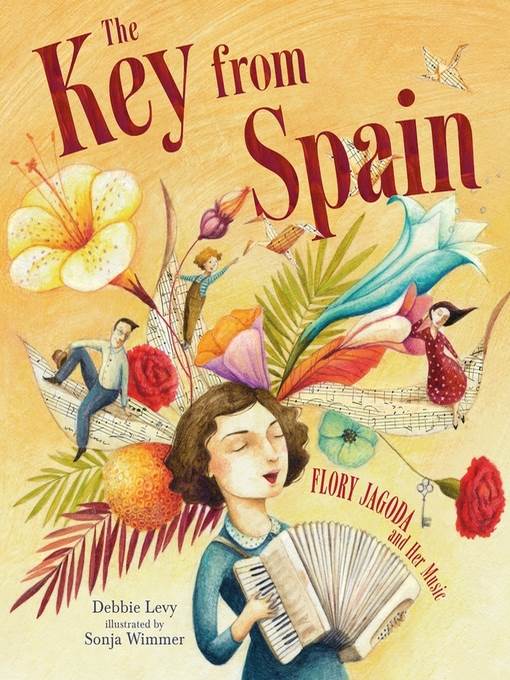
The Key from Spain
Flory Jagoda and Her Music
فرمت کتاب
audiobook
تاریخ انتشار
2019
Reading Level
3
ATOS
4.6
Interest Level
K-3(LG)
نویسنده
Book Buddy Digital Mediaشابک
9781541575370
کتاب های مرتبط
- اطلاعات
- نقد و بررسی
- دیدگاه کاربران
نقد و بررسی

June 1, 2019
Immigrant musician Flory Jagoda preserved a repertoire of Ladino and Sephardic songs learned from her Bosnian Jewish family. A descendant of the Altaras family forced to leave Spain during the Inquisition, Flory and her family must now escape from the Balkans during World War II. Crucial to the story of the Altaras' 16th-century exodus are the two symbols of their heritage: a key for their original home in Spain and Ladino, the traditional language of Spanish Jews. In the 20th century, Flory's childhood is filled with the stories Nona tells about their ancestors and the music played and sung in Ladino by her talented family. Living in peace and harmony among Jews, Christians, and Muslims, their happy life is threatened as the perils of World War II approach. Fortunate to escape the death the rest of her family suffers, Flory eventually sails to the U.S. without the important key but with her own three significant symbols: her accordion, her Ladino, and her music. Levy gently weaves the history of the Sephardim into the story of Flory's specific Balkan Jewish life, also blending in some italicized Ladino phrases and words (rendering "grandfather" as "Nonu" rather than the traditional "Nono"). Lovely mixed-media illustrations limn several scenes across the centuries, adding perspective to an element of Sephardic culture that is mostly unknown today in American Jewish circles. Based on a true story, an inspirational reclamation of history. (author's note) (Picture book/biography. 6-10)
COPYRIGHT(2019) Kirkus Reviews, ALL RIGHTS RESERVED.

Starred review from August 1, 2019
Gr 2-5-Levy's captivating picture book biography tells the story of Flory Jagoda, known today as the "Keeper of the Flame" of Sephardic culture and music. The narrative begins centuries after Flory's descendants, the Altaras family, were expelled from Spain during the Inquisition due to their Sephardic identity. After centuries of living peacefully in Bosnia, Flory's family had to escape the dangers of World War II for the same reason. Forced to flee her home for America, Flory relied on music to stay connected to her family's heritage, even as war ravaged her home and stole away her loved ones. Levy's writing and Wimmer's mixed-media illustrations strike the perfect synergy, working together to celebrate music, heritage, and family histories. The writing is poetic and lyrical, effortlessly weaving centuries of history into the story while maintaining a strikingly intimate tone. Wimmer's illustrations are nuanced, and readers will enjoy discovering new details upon each rereading of the book. VERDICT A beautifully crafted story that touches on a lesser-known historical topic. Together, the words and pictures convey musicality without a single note of harmoniku, Flory's instrument of choice, having to be played. This work is a must-purchase for library collections.-Lauren Hathaway, University of British Columbia
Copyright 2019 School Library Journal, LLC Used with permission.

July 1, 2019
Grades K-3 When the Altaras family leaves Spain following the Inquisition, they carry a key to their old house and Ladino, the spoken language of Sephardic Jews. In 1923, a girl named Flory is born into the Altaras family in Bosnia. She loves Ladino, music, and the harmoniku (accordion) given to her by her nona. In 1941, Flory must flee the Nazis, and playing music keeps her from being unmasked as a Jew. Later, she immigrates to America as a war bride, sharing music and Ladino with all. Levy's succinct text conveys the highlights of Jagoda's life as well as her love of the folk music that is central to Ladino culture. Wimmer's artwork utilizes maps, dates, and other imagery to convey a sense of the many time periods and places depicted. She also works Ladino words and phrases into her art, using strategic placement to ensure readers will grasp the meanings. With further information about Jagoda and links to her performances, this is a worthy (though fictionalized) homage to a language and its fervent promoter.(Reprinted with permission of Booklist, copyright 2019, American Library Association.)

























دیدگاه کاربران